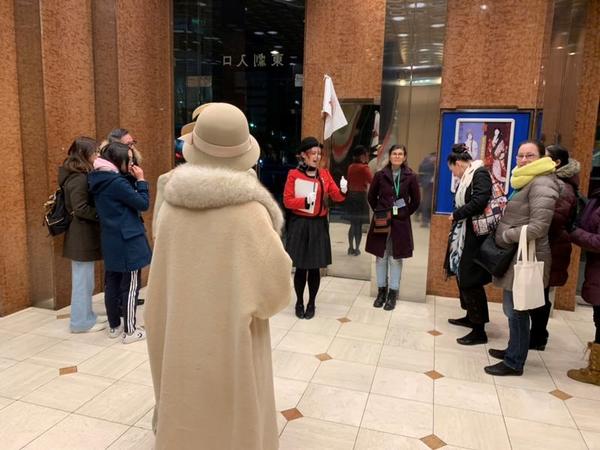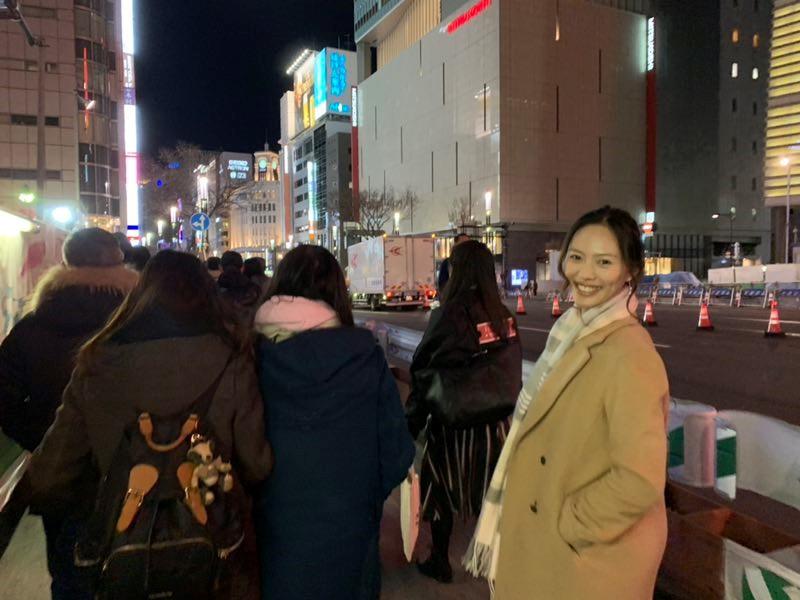Most people who visit Tokyo think of Ginza (銀座) as the neighborhood famous for its luxury shopping, restaurants, and entertainment venues. However, did you know that Ginza represents deep historical and cultural roots to the Japanese people? Besides having the largest Uniqlo store in the world, Ginza is home to historic buildings such as the Kabukiza Theater (Japan’s largest and most famous Kabuki theater), some of the most unique themed cafes in Tokyo, and the nostalgic Ginza Lion Beer Hall!
東京を訪れるほとんどの人は、銀座を高級なショッピング、レストラン、娯楽施設で有名な所だと思っています。 しかし、銀座は日本人にとって大切な歴史的、文化的な深いルーツでもありますね。 銀座には、世界で最大のユニクロ店があるほか、歌舞伎座、東京で最もユニークなテーマカフェ、懐かしい銀座ライオンビヤホールなどの歴史的建造物がたくさんありますよね。
To experience more of Ginza’s distinctive blend of the old and the new, I was invited to join the Ginza Theatrical Night Tour by Shochiku Co. Ltd., one of Japan’s oldest film studios and production companies famous for kabuki.
銀座の歴史をしるために、(株)松竹によって組織された「銀座劇場ナイトツアー」に行ってきました。
*~*~*~*
What is the Ginza Theatrical Night Tour??
銀座劇場ナイトツアーとは何ですか??


The tour offers a new “moving” sightseeing experience of the dazzling, neon-lit night in Ginza.
It is a new way to sightsee and stroll the streets of a historical Ginza while spectating and even becoming part of a theatrical play at the same time!
Sounds fun? Read on to join me on this exclusive tour!
銀座のネオンに照らされた夜の観光体験を提供するツアーです。
歴史的な銀座の街を見ながら散歩し、同時に観劇を観たり、私達が劇の一部にもなったりする新しい観光ツアーです。
楽しそうでしょう? この唯一のツアーについて読み続けてください!

*~*~*~*
| Ginza’s Historical Beginnings |
| Ginza was actually built upon a former swamp that was filled in during the 16th century. The name Ginza (銀座) in Japanese means “silver mint,” aptly named after the establishment of a silver-coin mint in 1612, during the Edo period. After the huge fire in 1872, the Meiji government designated Ginza as a model of modernization and center of Westernization featuring brick buildings instead of wood and better-connected streets. Irish-born architect Thomas Waters was commissioned to rebuild the Ginza area, designing many 2 to 3 story Georgian-style brick buildings. At the time, the area was known as “Renga Gai” meaning “brick town”.  Ginza appeared in the late 1870s-1880s (Miniature model at the Edo-Tokyo Museum) It was only after the 1923 Great Kanto Earthquake that Ginza truly evolved as an upmarket shopping district. The area flourished as a Japanese symbol of “civilization and enlightenment” helped by the presence of newspapers and magazine companies spreading new of the latest trends. The area was also known for modern marketing techniques such as introducing the first window displays in Japan.  The photo was taken in 1955 (Showa 30) – The clock tower above the Wako department store was built in 1932 by Hattori Kintaro – the founder of Seiko watches and still can be seen today. |
*~*~*~*
Historical Experience #1: Architecture
歴史的学習1:銀座の建築

The tour started at Togeki Cinema, a cinema operated by Shochiku that first opened in 1930. Togeki Cinema is renowned for its ‘Cinema Kabuki’ screenings of traditional Japanese theatre.
1930年にオープンした(株)松竹が運営する「東劇」でツアーが始まりました。「東劇」は日本の伝統的な「歌舞伎」を上映する劇場として有名です。

Togeki Cinema often features ‘Cinema Kabuki’ screenings of traditional Japanese theatre.
東劇は、しばしば伝統的な「歌舞伎」を「シネマ歌舞伎」として上映しています。

At the cinema, we were introduced to our guide and two special time travelling guests – Mobo (Modern Boy) and Moga (Modern Girl) from the 1930s! What a surprise that historical figures would be joining us on the tour!
映画館では、ガイドと1930年代の挌好として、2人の特別なゲスト、モボ(Modern Boy)とモガ(Modern Girl)が紹介されました!歴史上の人物がツアーに参加してくれたなんて驚きました!
| About “Modern Girl” and “Modern Boy” |
| “The Modern Girl [‘moga’, from modan (modern) garu (girl)] make only a brief appearance in our histories of prewar Japan. She is a glittering, decadent, middle-class consumer who, through her clothing, smoking, and drinking, flaunts tradition in the urban playgrounds of the late 1920s. Arm in arm with her male equivalent, the mobo (Modern Boy), and fleshed out in the Western flapper’s garb of the roaring twenties, she engages in ginbura (Ginza-cruising).– Erotic Grotesque Nonsense: The Mass Culture of Japanese Modern Times, by Miriam Rom Silverberg, 2009 |

Mobo and Moga would be sharing their memories of Ginza from the Edo period together with our guide as we embarked on our walking tour!
モボとモガは、江戸時代の思い出が残る銀座をガイドと一緒にウォーキングツアーに参加しました。

The first building pointed out was the Kabukiza Theater (歌舞伎座, Kabuki-za), the principal theater in Tokyo for the traditional kabuki drama form.
最初に示された建物は、歌舞伎座です。
This Theatre used to have 3 stories, but the top story was never fully reconstructed after being burned down by fire in the 1920s then bombings during World War. Nonetheless, it is still one of Tokyo’s more dramatic and traditional buildings.
歌舞伎座はかつて3階建てでしたが、最上階は1920年代に火事で焼失し、その後第二次世界大戦中に爆撃された後、完全に再建されることはありませんでした。 それにもかかわらず、その劇場はまだ東京の中では伝統の濃い建物の一つです。

Postcard depicting the pre-war reconstructed theatre (1924-1945)
戦前の再建された劇場を描いたポストカード

Incidentally, I had the chance to watch my first Kabuki performance recently!
ちなみに、私は最近初めて歌舞伎座で歌舞伎を観賞しました!

Outside of the Kabukiza Threatre. Although formal dress code is not mandatory when attending a play, often on the first day of a run, some ladies may attend the show dressed in traditional kimono, like my beautiful friend Yumi. ^^
歌舞伎座の外観で写真を撮りました。 公演の初日には、正式な服装規定は必須ではありませんが、友達の由美さんのように、何人かの女性が伝統的な着物姿で歌舞伎を見に行くことがあります。^^

Still vibrant and exciting to this day, Kabuki (歌舞伎) is a traditional Japanese form of theater with roots tracing back to the Edo Period. It is recognized as one of Japan’s three major classical theaters along with Noh and Bunraku, and has been named as a UNESCO Intangible Cultural Heritage.
ご存知と思いますが、歌舞伎は、今でも活気にあふれ、江戸時代にさかのぼることのできるルーツを持つ伝統的なお芝居です。 能楽や文楽とともに日本の三大古典劇のひとつとして認められ、ユネスコの無形文化遺産に指定されています。

The Kabukiza Theatre is known for being foreigner-friendly as they provide English support services and quite ingeniously sell single-act tickets on the day of the show. This option is best for those who are hesitant to spend too much time or money on a full performance, especially those who may be unfamiliar with the genre.
※If you plan to watch the full performance, be prepared to spend at least 4~5 hours in the theatre!
歌舞伎座は外国人に優しいことで知られています。英語のサポートサービスを提供し、ショーの当日には独創的なチケット(当日券)を販売しています。 このオプションは、フルパフォーマンスに多くの時間やお金を費やすことに躊躇している人、特にそのジャンルに不慣れな人に最適です。
皆様、歌舞伎座で歌舞伎を見に行ったことがありますか?歌舞伎についてどう思いますか?


次回は、銀座のシアターナイトツアーで銀座の歴史的なカフェカルチャーやナイトライフについて学んだことをシャアしたいと思います!
ぜひここをクリックしてくださいね~

*~*~*~*


About Shochiku
Founded in 1895, Shochiku started off with Kabuki theaters and has now established itself as a leading motion picture/theater producer, distributor, and exhibitor.
Besides sustaining Kabuki for over 100 years, Shochiku has also been active in the Japanese film industry as an independent distributor from its pioneer days.
The Company, which has always been a pioneer, produced the first color motion picture in Japan and was the creator of the world’s longest-running feature film series. It has also become a symbol of enduring tradition as the exclusive promoter of the kabuki theater in Japan.
The Company is continuing to develop its business and is making all possible efforts in various fields, including multimedia and the creation of international co-productions. The Ginza Theatrical Night Tour is just one way demonstrating how Shochiku is aware of the importance of offering cutting edge motion pictures and an innovative repertoire that can move and delight audiences.









